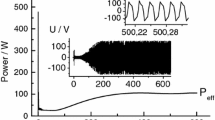Abstract
UTILISING an arrangement which permits working in an atmosphere of nitrogen and a Hilger quartz spectrograph model E/37 with Schumann plates (see details in Contrib. Estd. Ciencias Fis. Mat. Serie matemáticofisica, 4, 102; 1927, La Plata) we have investigated the persistence of the mercury line 1849·57. In the spark spectrum, using Gramont's fulgurator with solutions of mercury salts, Hg(CN)2, or Hg(NO3)2, it is only possible to register photographically the mercury line 1849·57 when working in an atmosphere of nitrogen (Fig. 1). In the arc spectrum, using McLennan's vacuum arc lamp and operating in a normal atmosphere, and in a nitrogen atmosphere, using carbon electrodes impregnated with the same mercury salts, the experimental results are strictly the same. These facts support the objection formulated by Gerlach (Phys. Berichte, 10, 429; 1929) with regard to my note published in Comptes rendus (187, 761; 1928). Operating in the conditions above described and with progressively diluted solutions of mercury salts, the persistence of the lines 2536·52 (1S3P) and 1942·0 (2S2P, Hg+) is much greater, in all conditions, than that of 1849·57. The latter line is a theoretical but not an experimental ‘raie ultime’ the true ‘raies ultimes’ of Hg are, in all conditions, 2536·52 and 1942·0. For this reason we consider that Meggers is mistaken in supposing (“Critical Tables”, 5, 323) that the line 1849·57 is the most persistent.
Similar content being viewed by others
Author information
Authors and Affiliations
Rights and permissions
About this article
Cite this article
WILLIAMS, A. Behaviour of the Mercury Line 1849·57 (11S0–21P1). Nature 124, 985–986 (1929). https://doi.org/10.1038/124985b0
Issue Date:
DOI: https://doi.org/10.1038/124985b0
- Springer Nature Limited




